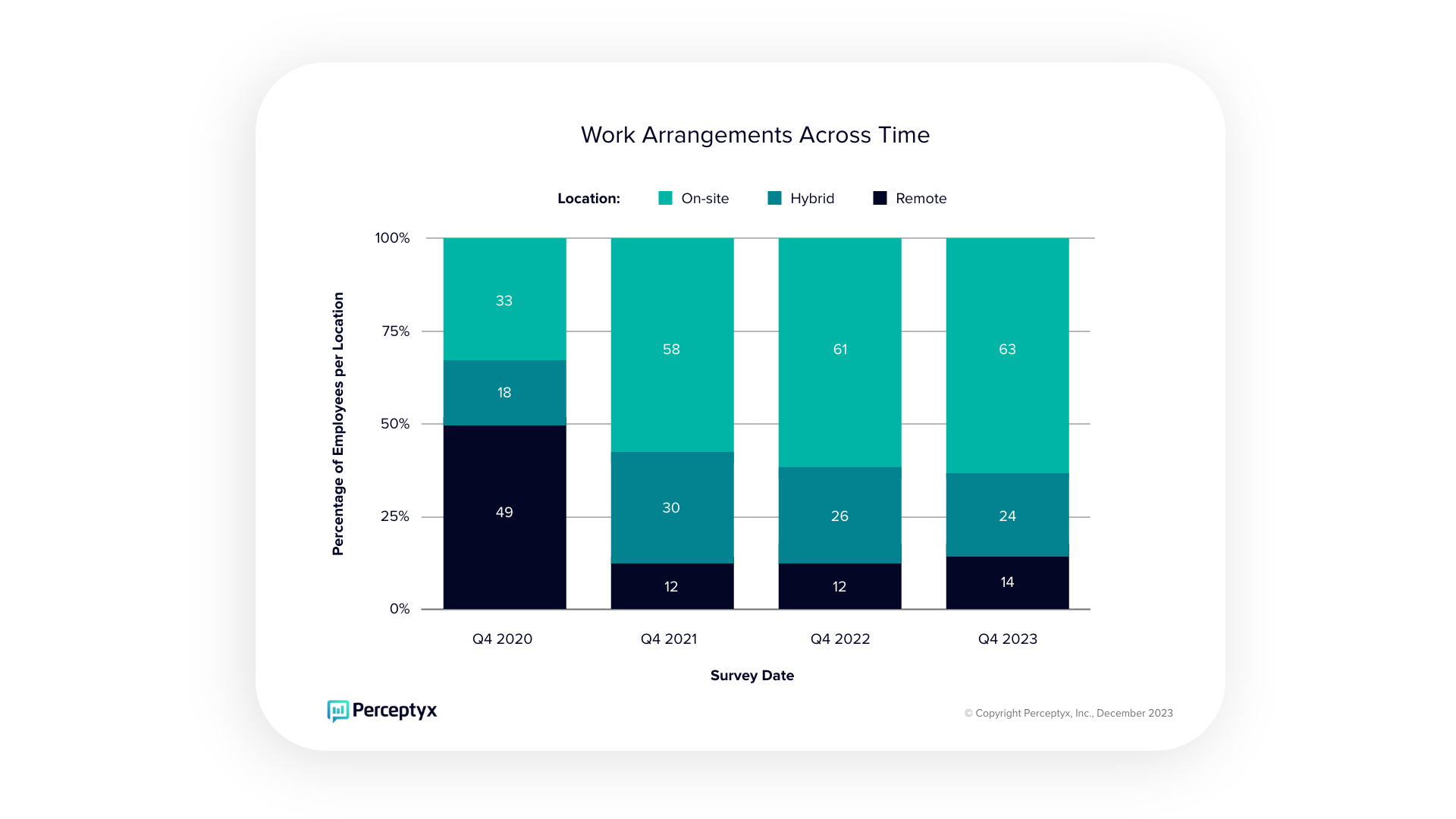The transition from traditional office settings to remote and hybrid models has become a defining feature of the post-pandemic world. Over the past three years, media narratives have focused on both the urgent necessity of remote work and, as the pandemic officially came to a close, the desire of many employers to get their people back into the office.
Stabilization of Remote and Hybrid Work Models
Our ongoing panel survey of U.S. working adults indicates a steady trend in the prevalence of remote and hybrid roles since the end of the pandemic. This stability suggests that employers are no longer aggressively pushing existing employees to return to the office en masse, a sentiment echoed in the broader job market.
However, our data reveals a nuanced picture when it comes to new employees. While overall figures for in-office work remain stable, there's a notable increase in the percentage of new hires working on-site. This shift — from 62% to 69% in just one year — signals a larger strategy by employers to gradually phase out remote roles for newcomers, suggesting that employers who have been unsuccessful in pulling existing staff back to an on-site work arrangement are instead pursuing on-site work through attrition.
A 2022 study by Perceptyx highlighted the benefits of hybrid work arrangements. Employees in these roles reported significant improvements in productivity, work-life balance, and mental health. This finding challenges the traditional 'officism' bias — the preconceived notion that people working on-site will be better employees — and underscores the need for a more flexible and empathetic approach to work arrangements.

Six Strategies for Overcoming "Officism" and Fostering an Equitable Workplace
As the workplace continues to shift and teams move from mostly remote to a mix that contains employees on-site full-time, workers who split their time between office and remote locations (hybrid), and those who remain fully remote, combatting "officism" becomes even more important. It is also essential for employers to listen to their employees and adapt their policies to meet the changing needs and preferences of their workforce. This could involve reevaluating office space usage, investing in technologies that support remote and hybrid work, and ensuring that all employees feel connected and engaged, regardless of their physical work location.
With that in mind, here are six data-driven strategies for overcoming officism and fostering an equitable workplace. By implementing the strategies discussed below, companies can create a workplace environment that respects and values the diverse preferences and needs of their workforce, fostering a culture of inclusivity, well-being, and productivity.
- Balance In-Person and Remote Interactions: The mix of workplace locations presents a unique challenge: balancing the need for in-person collaboration with the flexibility of remote work. Encouraging regular in-person interactions for team building and collaboration, while also maintaining the option for remote work, can help bridge the gap.
- Manage Performance to Objective Outcomes: Performance management plays a critical role in navigating the different work locations. This includes embracing a flexible leadership style that values both in-office and remote work contributions equally. Initiatives like designated remote work days or flexible hours can demonstrate a commitment to work-life integration. Ensuring that employees are held accountable to a specific set of performance criteria wards off the effects of proximity bias.
- Ensure Inclusive Practices for Hybrid Teams: Building a sense of community is crucial, especially for teams split between remote and in-office settings. Set meeting norms to ensure those dialing in from elsewhere are included in the conversation. Handling key business issues in the meeting and not in the hallway afterward, providing a lunch gift card for remote workers when catering lunch for in-person staff, and keeping track of growth opportunities to ensure “out-of-sight” does not mean “out-of-mind,” are all ways to create equity regardless of work location.
- Make Resources Available Where Employees Are: Resource accessibility should be uniform regardless of an employee’s work location. This includes making sure that Employee Resource Groups (ERGs) and advisory groups are accessible and relevant to both remote and in-office employees. Resources and communication channels should be equally available, ensuring that remote employees don’t feel disconnected.
- Listen to and Act On Employee Feedback: When employees are not co-located with their managers and teams, understanding their perceptions, bright spots, and concerns takes on even more significant meaning. Such programs should focus on understanding employees’ individual needs and what local and systemic actions are needed to provide a great work experience. Leadership training in emotional intelligence can aid in creating an environment where all employees feel valued and heard.
- Approach Employee Well-being Holistically: Acknowledging the interconnection between physical and mental health in the workplace is key. Those employees working on-site each day may have different concerns and challenges than those working from their home offices. Companies should offer programs that are tailored and accessible to both remote and in-office employees, like online mindfulness sessions, virtual fitness classes, and webinars on nutrition and healthy living. This holistic approach ensures that all employees have equal access to the physical and mental well-being resources they need most.
Perceptyx Plays a Key Role in Connecting Employers and Employees
Perceptyx stands at the forefront of bridging the gap between employers and employees in an evolving work paradigm that encompasses remote, hybrid, and on-site workers. Our People Insights Platform offers listening solutions and data-driven insights to guide organizations in understanding and addressing the needs of their workforce in these changing times. To learn more, schedule a meeting with a member of our team.
